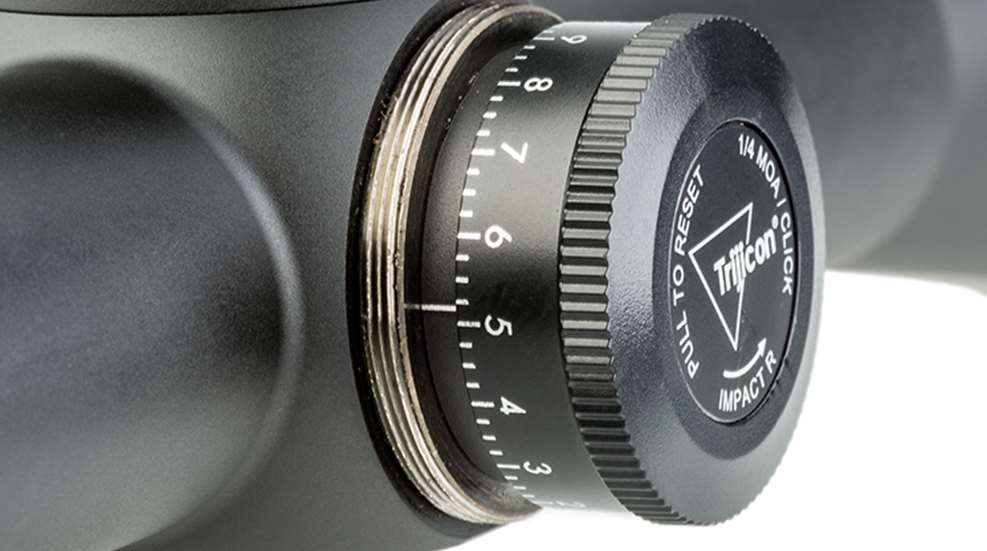
How much treestand or elk mountain cred is Trijicon due given how well its rock-hard battle-rifle sights have served U.S. troops at war? That was the obvious question when the company diversified into all-purpose riflescopes a few years back, and it remains a key issue with the recent introduction of the AccuPower, a four-scope collection largely geared toward big-game hunters.
The AccuPowers differ from the first-gen AccuPoints in some significant ways, but what’s immediately apparent is how solid they are, just like the earlier scopes, and just like Trijicon ACOG and RMR combat sights. You won’t find any plastic parts on an AccuPower. Apart from lens surfaces, what you get is a precision-machined billet of aircraft-grade, hard-anodized aluminum rendered in the bulbous lines of high-end European optics. It’s a unit that feels a bit heavy for its size. Under the tight-fitting turret caps, you find adjustment wheels that turn a bit stiffly and click-stops as deliberate as those on a high-grade socket wrench. The magnification ring is equally stiff and sure-handed. There’s no slop.
There’s a reason why I’m choosing to focus first on ruggedness and durability. While I appreciate light transmission and sharpness as much as the next gear-head, what matters most to me is that a scope holds its zero and proves so dependable and durable that I come to take for granted it’ll shoot straight and deliver useful sight pictures every time out for as long as I own it. That’s the same if it costs $300 or five times that much.
In fact cost is one key difference between the AccuPower and its AccuPoint predecessor. Selling via online outlets at prices ranging from $600 to $900, the new line costs roughly 25 percent less.
The major functional change in the AccuPower is how the illuminated reticle works. Whereas the AccuPoint—like other mainstay Trijicon optics—relies on tritium plus fiber optics to power its reticle, the AccuPower contains a battery. The reticle is in the second focal plane (non-magnifying) and can be had in red or green, delivered by an LED in 11 brightness increments with “off” between each step. The turret adjustment click values are the familiar .25 MOA or .1 mil. Battery life at max setting is rated at 31 hours, though that level would be too bright for me in any scenario short of glaring snow cover.
For all but the fussiest users, the AccuPower’s imaging performance will be more than satisfactory. The field it delivers is evenly sharp and clear, with only minimal fringing in transitional minutes early and late in the day. And in fact the hunting day was all but over as outfitter Hunter Ross and I hurried to close in on a big axis buck traveling with a 20-doe harem and a few acolyte bucks.
We hit now-or-never time at 180 yards, the only option being a shot from sticks. As the lead does trotted off, I waited for the spotted buck to clear a fringe of cover, then when it stepped free the opportunity crystallized and my shot hit true. In the 10 minutes it took to cross the draw to where the herd buck lay dead, the full moon came up over the Texas Hill Country. Though it was early July, these bucks had just shed velvet and were entering their rut, acting much like elk in the way they vocalized and tended females. They were rangier than our native whitetails and were spooky as deerkind should be. Fortunately, herd numbers were high, and not because the ranch’s wildlife could not move on. We had left the high fences behind and were hunting strictly free-ranging game. Two days later, my partner, Trijicon’s Chuck Wahr, also got his chance right before quitting time but not without some busted stalks along the way. It was one of the first hunts with his company’s new scopes and a fitting debut.
Later, I compared the 3X-9X-40mm AccuPower side-to-side with an AccuPoint having the same specs and found their image-transmission capabilities quite close. I spied two young velvet-antlered whitetails browsing in deep shadows at dusk and could clearly count five little points on one deer and three on the other. With both scopes I could read headlines like the one on this spread at 83 yards (in full daylight), and from 100 yards, I could distinguish black-and-white soccer ball sections until 20 minutes after sunset. In virtually all legal daylight hunting, Trijicon scopes will hang in well past the end. The AccuPower’s field of view is also marginally wider than what you’ll see through most other brands, including the AccuPoint.
The only trouble I ran into was mounting the scope on a long-action Weatherby Mark V. Both the objective bell and eyepiece are lengthy, so there’s not much free tube. That’s not going to pose a problem on short-action rifles or when using one-piece bases, but owners of certain long- and magnum-length hunting rifles may need to use extension rings. These scopes are about 20 percent heavier than the corresponding AccuPoints—which certainly will be a concern to mountain hunters. For the rest of us, that bulk, which I believe reflects the scopes’ inherent ruggedness, can actually help us hold our rifles steadier when shooting.
With just four models, it’s probably a stretch to say the AccuPowers can do it all, but in fact they intelligently span the current rifleman’s landscape. Apart from its green LED reticle, my 3X-9X-40mm test unit built on a 1-inch tube is as mainstream as big-game optics come. The others, all with 30mm tubes, will meet the diverse needs of today’s shooters and hunters, from 3-gun and AR fans favoring the 1X-4X-24mm (also perfect for dangerous game), to tactical and long-range guys who want bigger glass in the form of the 2.5X-10X-56mm or the 4X-16X-50mm. You can feel the soundness in these optics and the Trijicon mil-spec DNA is unmistakable. That merits a whole lot of cred in my book.
Technical Specifications:
• Type: variable-power riflescope
• Magnification: 1X-4X, 3X-9X (tested), 2.5X-10X, 4X-16X
• Objective Lens Diameter: 24mm, 40mm (tested), 50mm, 56mm
• Eye Relief: 3.7"-3.5"
• Exit Pupil: 13.3mm (3X), 4.4mm (9X)
• Field of View @ 100 Yds: 35.5' (3X), 11.8' (9X)
• Reticle: second focal plane; illuminated; Duplex (tested), MOA, Mil-Square, Segmented Circle-Dot; CR2032 lithium battery power source
• Adjustments: .25 MOA
• Coatings: fully multi-coated
• Dimensions: tube diameter 1"; length 12.3"; weight 17 ozs.
• Construction: one-piece, hard-anodized aluminum tube; nitrogen-filled, waterproof, fog-proof
• MSRP: $699
![]()





































